Lancaster’s Theater Row & The Krupa Family Empire
The Fulton Theatre’s second main stage production for its 2018-2019 season, 42nd Street, entertained audiences for the holidays from November 13 – December 30, 2019. If you joined LancasterHistory.org for Thirsty for History Thursday at the Fulton on Thursday, November 29, you would have been regaled with plethora of historical information, tying Lancaster County’s history with elements, themes, and motifs from 42nd Street. If you missed it, now is your chance to catch up on what you missed!
North Queen Street: Lancaster’s Theater Row & The Krupa Family Empire

George Krupa was born on July 5, 1873 in what’s now the modern day Czech Republic, and immigrated to the United States in 1898. He settled near Pittsburgh where he dug coal, but always had a dream of owning his own theater. The story goes that he studied a map of Pennsylvania and decided Lancaster would be a good place to launch a new theater. And when he arrived, he knew he was on the right track.
Krupa first arrived in Lancaster in 1906. He opened the Dreamland Theater on the first block of North Queen Street (43 North Queen), right next to the Examiner Building. It had 160 seat capacity. He bought his first projector from Sears & Roebuck. The Dreamland was your basic “Nickelodeon” theater – for 5 cents admission viewers saw a 2 reel feature, a Pathe news reel, and a reel showing the latest fashions from Paris. Sometimes there would be a “Magic Lantern” show – still images projected with a stereopticon to create a story. The Dreamland eventually expanded to 460 seats.

In 1911, Krupa married Elsie Johns Shaub, a young widow with four children who was a talented piano player. She became his inspiration and business partner. Her children even took his last name. Catharine and Bertha, her two oldest children, would go on to play the organ at the various Krupa-owned theaters.

In 1912, the Krupas opened the Hippodrome in the second block of North Queen Street (150 North Queen). It had a 1200 seat capacity and a large lobby with an elaborate fountain in the center. It was here that Lancastrians would flock to see films like “The Vamp”, “Queen Elizabeth”, and “The Keystone Kops”.
The Krupa family acquired the Hamilton in 1916. Like the Hippodrome, it was also in the second block of North Queen Street (158 North Queen). It was at the Hamilton that the 80 piece Russian Symphony Orchestra played for a standing room only crowd. Also, vaudeville acts like the Hopi Indian Tribe performed here. And rumor has it that famous local boxer Leo Houck always liked to sit eighth row, left.

The Hippodrome was renovated in 1924 for 900 seats. It boasted fancy crystal chandeliers and an organ designed by George and Elsie’s daughter, Catharine Krupa. Sadly, the theater burned to the ground on December 29, 1924 – the night before it was to open.
In 1926, the Aldine was rebuilt and renamed the Capitol. It had a 1300 seat capacity, marble floors and columns in the main floor and mezzanine lobbies, a $3000 tapestry that was kept in a vault prior to opening night, separate lounges for ladies and gentlemen, draperies of damask and velvet, a circular dome ceiling in the auditorium with a huge crystal chandelier, and even an emergency room with an attendant. The building was designed by William H. Lee of Philadelphia and the interior was decorated by Charles Hottinger of New York. And because of the previous fire, the Krupas spared no expense in installing an “Automatic Fireman” sprinkler system and steel fire doors that proved (ironically) difficult to remove during demolition in 1967’s Urban Renewal.

The Krupas also ran theaters in Harrisburg – the Rialto and the National. Catharine and Bertha Krupa played the organ at the Capitol and the Hamilton, as well as the Fulton Opera House. Live music was an integral part of silent moving picture shows. With the advent of “talkies”, the need for music and live sound dwindled and changed the presentation of moving pictures and the function of movie theaters.
At the end of 1926, the Krupas sold the Hamilton and the Capitol to the Stanley Corporation for $500,000 – a more than a tidy sum in the 1920s. Unfortunately, they lost most of their fortune in the stock market crash of 1929. The Krupas lived for a time in Wheeling, West Virginia, but returned to Lancaster in the late 1930s.
George Krupa returned to the Capitol in 1938, not as an owner or manager, but as a janitor and fireman – just so he could be near the theater he built. He was still a revered figure in the theater and everyone still called him “Boss”. By all accounts, he was never bitter about losing his fortune. He was just amazed that an immigrant could come to America, live out his dream, and earn a good living doing what he loved. He always felt lucky. George Krupa died January 1, 1961.
Love the combination of local history and theater? Visit the Fulton Theater for their next main stage production, Chicago, on Thursday, January 31 for our next Thirsty for History Thursday at the Fulton! Read more here.
Featured image courtesy of the Fulton Theatre.
From Thirsty for History